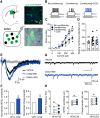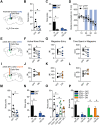Indirect Medium Spiny Neurons in the Dorsomedial Striatum Regulate Ethanol-Containing Conditioned Reward Seeking
- PMID: 31315945
- PMCID: PMC6733541
- DOI: 10.1523/JNEUROSCI.0876-19.2019
Indirect Medium Spiny Neurons in the Dorsomedial Striatum Regulate Ethanol-Containing Conditioned Reward Seeking
Abstract
Adenosine 2A receptor (A2AR)-containing indirect medium spiny neurons (iMSNs) in the dorsomedial striatum (DMS) contribute to reward-seeking behaviors. However, those roles for ethanol-seeking behaviors remain unknown. To investigate ethanol-seeking behaviors, we used an ethanol-containing reward (10% ethanol and 10% sucrose solution; 10E10S). Upon conditioning with 10E10S, mice that initially only preferred 10% sucrose, not 10E10S, showed a stronger preference for 10E10S. Then, we investigated whether the manipulation of the DMS-external globus pallidus (GPe) iMSNs circuit alters the ethanol-containing reward (10E10S) seeking behaviors using the combination of pharmacologic and optogenetic approaches. DMS A2AR activation dampened operant conditioning-induced ethanol-containing reward, whereas A2AR antagonist abolished the effects of the A2AR agonist and restored ethanol-containing reward-seeking. Moreover, pre-ethanol exposure potentiated the A2AR-dependent reward-seeking. Interestingly, mice exhibiting ethanol-containing reward-seeking showed the reduction of the DMS iMSNs activity, suggesting that disinhibiting iMSNs decreases reward-seeking behaviors. In addition, we found that A2AR activation reversed iMSNs neural activity in the DMS. Similarly, optogenetic stimulation of the DMS-GPe iMSNs reduced ethanol-containing reward-seeking, whereas optogenetic inhibition of the DMS-GPe iMSNs reversed this change. Together, our study demonstrates that DMS A2AR and iMSNs regulate ethanol-containing reward-seeking behaviors.SIGNIFICANCE STATEMENT Our findings highlight the mechanisms of how operant conditioning develops the preference of ethanol-containing conditioned reward. Mice exhibiting ethanol-containing reward-seeking showed a reduction of the indirect medium spiny neuronal activity in the dorsomedial striatum. Pharmacological activation of adenosine A2A receptor (A2AR) or optogenetic activation of indirect medium spiny neurons dampened operant conditioned ethanol-containing reward-seeking, whereas inhibiting this neuronal activity restored ethanol-containing reward-seeking. Furthermore, repeated intermittent ethanol exposure potentiated A2AR-dependent reward-seeking. Therefore, our finding suggests that A2AR-containing indirect medium spiny neuronal activation reduces ethanol-containing reward-seeking, which may provide a potential therapeutic target for alcohol use disorder.
Keywords: A2AR; dorsomedial striatum; ethanol; medium spiny neuron; reward.
Copyright © 2019 the authors.
Figures








Similar articles
-
Astrocyte-neuron interaction in the dorsal striatum-pallidal circuits and alcohol-seeking behaviors.Neuropharmacology. 2021 Oct 15;198:108759. doi: 10.1016/j.neuropharm.2021.108759. Epub 2021 Aug 22. Neuropharmacology. 2021. PMID: 34433087 Free PMC article. Review.
-
Astrocytic equilibrative nucleoside transporter type 1 upregulations in the dorsomedial and dorsolateral striatum distinctly coordinate goal-directed and habitual ethanol-seeking behaviours in mice.Eur J Neurosci. 2020 Aug;52(3):3110-3123. doi: 10.1111/ejn.14752. Epub 2020 May 13. Eur J Neurosci. 2020. PMID: 32306482 Free PMC article.
-
Novel Adenosine Analog, N6-(4-Hydroxybenzyl)-Adenosine, Dampens Alcohol Drinking and Seeking Behaviors.J Pharmacol Exp Ther. 2019 Nov;371(2):260-267. doi: 10.1124/jpet.119.261529. Epub 2019 Aug 13. J Pharmacol Exp Ther. 2019. PMID: 31409667 Free PMC article.
-
Caspase-dependent ablation of indirect medium spiny neurons projecting to external globus pallidus promotes compulsive ethanol-seeking and drinking behaviors.bioRxiv [Preprint]. 2025 Feb 25:2025.02.21.639573. doi: 10.1101/2025.02.21.639573. bioRxiv. 2025. PMID: 40060666 Free PMC article. Preprint.
-
Adenosine signaling in striatal circuits and alcohol use disorders.Mol Cells. 2013 Sep;36(3):195-202. doi: 10.1007/s10059-013-0192-9. Epub 2013 Aug 1. Mol Cells. 2013. PMID: 23912595 Free PMC article. Review.
Cited by
-
Striatopallidal adenosine A2A receptor modulation of goal-directed behavior: Homeostatic control with cognitive flexibility.Neuropharmacology. 2023 Mar 15;226:109421. doi: 10.1016/j.neuropharm.2023.109421. Epub 2023 Jan 10. Neuropharmacology. 2023. PMID: 36634866 Free PMC article. Review.
-
Astrocyte-neuron interaction in the dorsal striatum-pallidal circuits and alcohol-seeking behaviors.Neuropharmacology. 2021 Oct 15;198:108759. doi: 10.1016/j.neuropharm.2021.108759. Epub 2021 Aug 22. Neuropharmacology. 2021. PMID: 34433087 Free PMC article. Review.
-
Mechanism of opioid addiction and its intervention therapy: Focusing on the reward circuitry and mu-opioid receptor.MedComm (2020). 2022 Jun 22;3(3):e148. doi: 10.1002/mco2.148. eCollection 2022 Sep. MedComm (2020). 2022. PMID: 35774845 Free PMC article. Review.
-
Astrocytic equilibrative nucleoside transporter type 1 upregulations in the dorsomedial and dorsolateral striatum distinctly coordinate goal-directed and habitual ethanol-seeking behaviours in mice.Eur J Neurosci. 2020 Aug;52(3):3110-3123. doi: 10.1111/ejn.14752. Epub 2020 May 13. Eur J Neurosci. 2020. PMID: 32306482 Free PMC article.
-
Chemogenetic inhibition in the dorsal striatum reveals regional specificity of direct and indirect pathway control of action sequencing.Neurobiol Learn Mem. 2020 Mar;169:107169. doi: 10.1016/j.nlm.2020.107169. Epub 2020 Jan 20. Neurobiol Learn Mem. 2020. PMID: 31972244 Free PMC article.
References
-
- Aoun EG, Jimenez VA, Vendruscolo LF, Walter NAR, Barbier E, Ferrulli A, Haass-Koffler CL, Darakjian P, Lee MR, Addolorato G, Heilig M, Hitzemann R, Koob GF, Grant KA, Leggio L (2018) A relationship between the aldosterone-mineralocorticoid receptor pathway and alcohol drinking: preliminary translational findings across rats, monkeys and humans. Mol Psychiatry 23:1466–1473. 10.1038/mp.2017.97 - DOI - PMC - PubMed
Publication types
MeSH terms
Substances
Grants and funding
LinkOut - more resources
Full Text Sources
Other Literature Sources
Medical
Molecular Biology Databases
